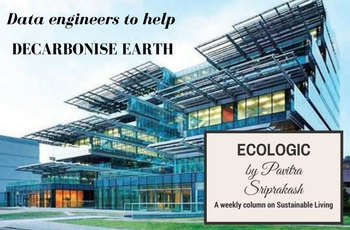01 Jul 2017, New Indian Express: ECOLOGIC- Pavitra Sriprakash, the Chief Designer and Director of Shilpa Architects writes about applying big data gathering and analysis to sustainability.
Read More: Link to New Indian Express Site | PDF | Full Text below
Data engineers to help decarbonise EarthBy Pavitra Sriprakash | Published: 01st July 2017 Data Engineering is the latest buzzword among students heading abroad for their Masters in ivy-league schools. No longer is proficiency in IT or software a guarantee for coveted opportunities. The new frontiers of sustainable technologies are about mining and applying big data, and education is about pursuing qualifications that enable cutting edge research in related fields. The triennial World Sustainable Built Environment Conference (WSBE) just concluded in Hong Kong. The gathering of sustainability experts, researchers and construction leaders from the building industry agreed they were starved of data. If this sector were to ‘de-carbonise’ by 2050, then it may be possible to keep temperatures from rising beyond two degrees centigrade as agreed in the Paris Protocol. Buildings contribute about 30% of the total global energy use and emissions, but the lack of data and deployment systems are hampering the ‘de-carbonisation’ initiative. Many policy level decisions about rapid urbanisation or gentrification of urban areas are nowadays being made with insufficient information. City leaders have scant information about prevailing building inventories and their power consumption patterns. If there is no easy metric to measure the energy efficiency of a building, then how can we manage it? The constant challenge for architects is to nudge acceptance towards new, sustainable and energy efficient technologies overlooking standard methods and materials. Clients always want to know a priori how much more a recommended alternative will cost and what will be the return on investment. However, reliable data is not yet available for design professionals to decisively answer these larger questions. Life cycle costs and energy data for a lot of building products are scarce. Carbon conversion factors — formulae that calculate resultant carbon emissions — are not comparable for different products, and especially so for new technologies and innovations. This makes ready all round acceptances of some new alternatives more difficult. Yet we need to continuously push the market away from inefficient solutions. This effort would be easy if energy performance standards were available for all types of constructions and upgradations; and if similar data were in place for new equipment, materials and fixtures. There are enough examples to prove that the move to energy efficient ideas need not always translate into bigger spending. A great example is the public acceptance of energy saving LED lamps, which have gained a 30% market share in just four years. Data is a powerful tool to decarbonise our built environment. We just have to innovate and deploy it to gain wider market acceptance. That’s the future — hug it! |



